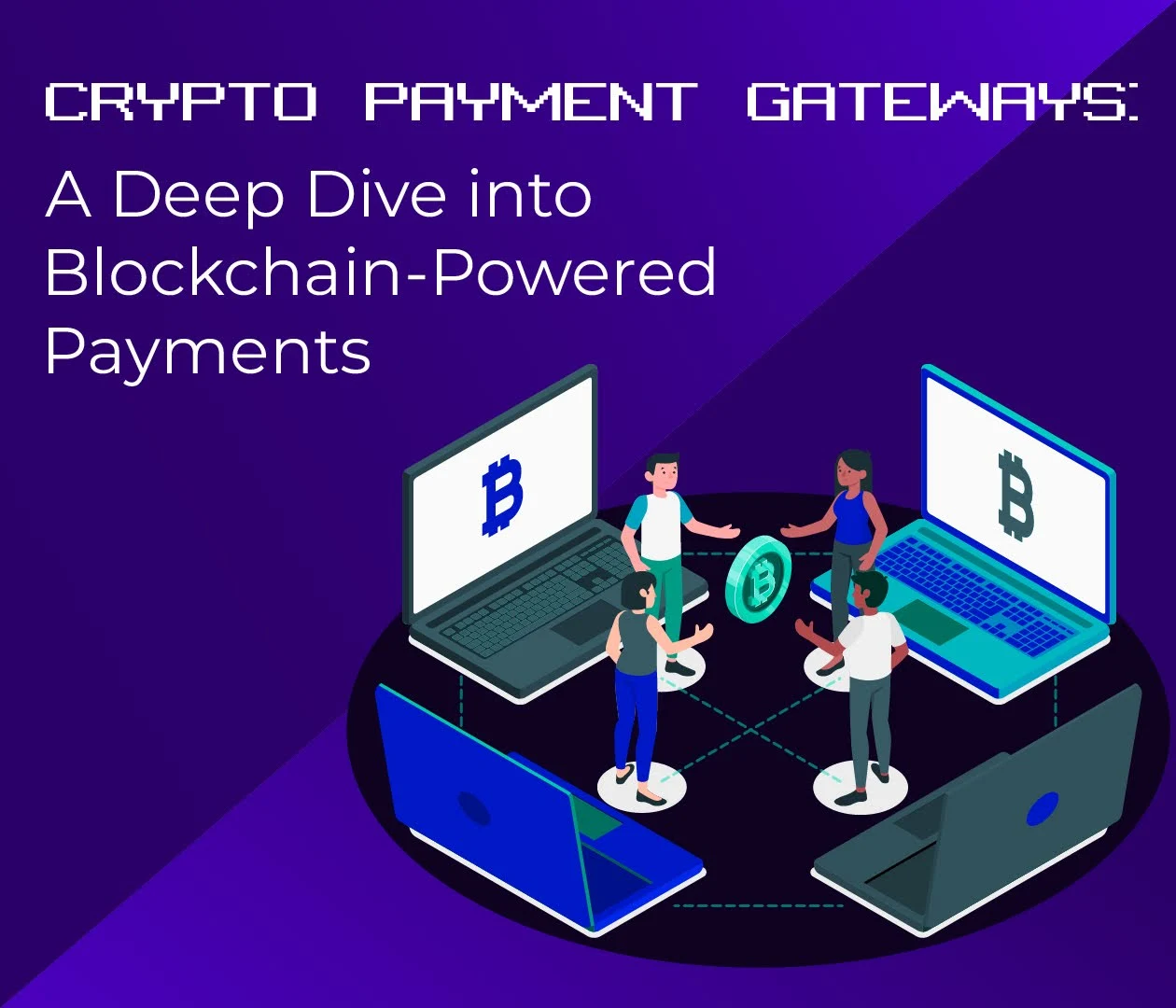Crypto Payment Gateways: A Deep Dive into Blockchain-Powered Payments
Thousands of people shop and do business online daily, and there’s an ever-growing need for fast, secure, and easy payment systems. Crypto payment gateways meet this demand by combining the efficiency of digital technology with the security of blockchain, providing a seamless way for people to make and receive payments.
Whether you’re a merchant looking to integrate cryptocurrency into your payment options or a tech enthusiast fascinated by digital finance, this article will provide a detailed overview of how crypto payment gateways work, the problems they solve, and their impact on global commerce. Let’s dive into it!
What are crypto payment gateways?

Crypto payment gateways are platforms or services that allow merchants and businesses to accept cryptocurrency (like Bitcoin, Ethereum, Solana, Dogecoin, etc) as a form of payment for goods and services.
They serve as intermediaries between customers, merchants, and the blockchain network to process cryptocurrency transactions. They also convert the cryptocurrencies into the merchant’s preferred currency or allow the merchant to keep the payment in the original cryptocurrency.
Key components of crypto payment gateways
1. Digital wallet compatibility
Crypto payment gateways function by integrating with cryptocurrency (or digital) wallets. A cryptocurrency wallet is a digital tool that allows users to store, send, and receive digital currencies. When a user chooses to make a purchase through a payment gateway, they use their crypto wallet to initiate the transaction.
This wallet holds their cryptocurrency and then interfaces with the payment gateway to process the transaction.
2. Wallet management
Crypto payment gateways create digital wallets that smoothly process transactions while securing users’ assets from theft or loss using private keys and seed phrases, which are crucial for the operation and security of their accounts.
Seed phrases are a series of 12 to 24 words generated by a cryptocurrency wallet when it was first created. If a user ever loses access to their wallet due to theft or device failure, the seed phrase can be used to restore the wallet and its contents to a new device. On the other hand, private keys are an alphanumeric string used to secure and authenticate transactions on the blockchain and cryptocurrency systems.
3. Blockchain technology
A blockchain is a decentralized and immutable digital ledger that records transactions and tracks the flow of digital assets across its network. Blockchain technology is a crucial part of crypto payment gateways because it provides a safe and secure transaction framework. How?
- Cryptographic techniques
The crypto blockchain uses complex mathematical algorithms to keep transactions secure. Each transaction is encrypted and linked to the previous one with a unique code, creating a block of chains (pun intended) and making the blockchain ledger immutable—which means that once a transaction has been added to the blockchain, it can’t be changed or removed.
- Decentralized operations
Blockchain technology operates on a decentralized system, meaning that no single entity owns or controls the data on the network. Rather, the system is spread across several computers (also known as nodes) worldwide.
Plus, each transaction on the blockchain must be approved by multiple nodes based on consensus algorithms like Proof of Work or Proof of Stake. This ensures the system is less vulnerable to hacks, manipulation, or operational failures.
4. User interface
Crypto payment gateways have a front-end through which merchants and customers interact. For customers, this means options to select different cryptocurrencies, input their wallet addresses, and confirm transaction details on checkout pages.
For merchants, the user interface provides a more comprehensive dashboard that gives them access to transaction histories, settings for managing crypto preferences, analytical tools, and more.
5. Transaction engine
The transaction engine is the backbone of a crypto payment gateway; it processes all transactions—from initiation to confirmation. Its processes include:
- Generating transaction requests.
- Creating unique wallet addresses and QR codes for payments.
- Processing payments once they’re initiated by customers.
- Verifying transactions through the blockchain network.
- Confirming the final transaction status to both the customer and the merchant.
6. Exchange rate calculator
Crypto payment gateways have an exchange rate calculator that tracks the latest exchange rates across various digital currency exchanges to provide real-time prices.
When a transaction is initiated, the exchange rate calculator calculates the exact equivalent of regular currency (e.g., dollars, naira, or pounds) so merchants and customers can agree on the value of the transaction at the point of sale.
7. Currency conversion
For merchants or businesses who prefer not to hold cryptocurrency because of its unstable nature, crypto payment gateways convert cryptocurrency into fiat (regular) currency. This usually involves partnering with financial institutions that can provide liquidity. Afterward, the converted funds are deposited into the merchant or business’s bank account within a specific time frame.
8. Regulatory compliance monitoring
Regulatory compliance monitoring is an essential component of crypto payment gateways—especially considering the complex and frequently evolving nature of cryptocurrency regulation. Crypto payment gateways ensure that users are operating within legal boundaries by implementing:
- KYC (Know Your Customer) procedures
KYC procedures involve collecting and validating users’ personal information, like names, addresses, and government-issued identification numbers. The essence of KYCs is to aid in tracking funds if necessary and ensure that the crypto payment gateway isn’t used for fraudulent purposes.
- AML (Anti-Money Laundering) compliance
AML protocols monitor all transactions processed through a payment gateway for signs of money laundering, such as frequent small transactions (a money laundering technique known as smurfing) and unusually large or high-risk transactions.
- International sanction screening
Payment gateways screen their users on international sanctions lists to ensure that they don’t process transactions that could involve countries, organizations, or individuals subject to sanctions, as this can lead to significant legal implications.
9. Customer service and support

Effective customer service is necessary for the success of any payment platform, and crypto payment gateways provide support to their users via multiple channels. This includes live chat, email, and phone support to address any issues around transactions, technical difficulties, or users’ complaints.
10. Robust security infrastructure
Crypto payment gateways use various technologies and protocols to protect users from cyber threats. This cuts across encryption practices, anti-fraud mechanisms to track suspicious transaction patterns, SSL/TLS implementation for secure data transmission, and regular blockchain security audits.
How do crypto payment gateways work?

Crypto payment gateways serve as a viable alternative to traditional payment systems like cash, credit cards, and cheques, enabling merchants and customers to transact using digital currency like Bitcoin and Ethereum. Here’s a step-by-step breakdown of how crypto payment gateways work:
1. Integration with the merchant’s system
Before a business can accept cryptocurrency payments, it must integrate a crypto payment gateway with its e-commerce platform or point-of-sale (POS) system. This integration is often done through APIs (Application Programming Interfaces) or plugins that the gateway provider offers.
This allows them to offer cryptocurrency as a payment option alongside traditional payment methods like credit cards and bank transfers.
2. Payment information is generated
When a customer selects cryptocurrency as a payment method for a purchase, the crypto gateway immediately generates a payment request. This request includes a unique wallet address for the transaction and a QR code that customers can scan with their digital wallet app.
The gateway then automatically calculates the amount payable in the chosen cryptocurrency—based on the current exchange rates—and the merchant’s preferred fiat (regular) currency.
3. Transaction initiation by the customer
After the payment request is generated, the customer initiates the payment by using their digital wallet to send the correct amount of cryptocurrency to the address provided. This usually involves scanning the QR code or manually entering the wallet address.
4. The blockchain verifies the transaction
Once the customer sends funds from their wallet to the generated address, the transaction is broadcast to the cryptocurrency’s blockchain network. This begins a verification process to confirm that the payment has been made and the transaction isn’t fraudulent. The number of confirmations required usually varies, depending on the blockchain and the payment gateway’s security standards.
5. The transaction is confirmed
Once the blockchain network confirms the transaction, the payment gateway notifies the merchant that the payment has been received. Then, depending on the merchant’s preferences, the payment can be retained as cryptocurrency or automatically converted into fiat currency.
If the merchant chooses to convert it, the gateway handles the exchange, and the money is transferred to their bank account, usually within a few days.
6. The transaction is recorded on the blockchain
Now that the transaction is complete, the payment gateway records the entire process on the blockchain. So, merchants can use the data to manage their accounts, track sales, and process refunds if necessary.
Pros of Crypto Payment Gateways

What are the benefits of using crypto payment gateways? Here are some of them:
Access to a global market
Crypto payment gateways enable merchants and businesses to accept payments from customers anywhere in the world without dealing with international banking fees or currency conversion. This opens up access to a global market, especially for online businesses.
Moreso, crypto payment gateways allow transactions from customers who don’t have access to traditional banking services but can access the internet. This inclusivity broadens the customer base for businesses and provides a means of financial transactions for people without bank accounts.
Fast transaction speed
Due to the lack of intermediaries and a fast verification process on blockchain networks, cryptocurrency transactions are significantly faster than traditional banking transactions, especially in international payments.
Low transaction fees
Traditional payment methods often come with high fees, but crypto payment gateways generally charge lower transaction fees, making them a cost-effective option for small and large transactions.
No chargebacks
A chargeback is a process by which a customer can request their bank or credit card issuer to reverse a transaction that has already been completed. This is a common fraud method in credit card transactions, often leading to losses for merchants. Fortunately, once the blockchain network has confirmed a transaction on crypto payment gateways, it can’t be reversed.
Advanced security
Crypto payment gateways leverage the advanced security of blockchain technology, which uses complex cryptographic techniques to secure transactions. Each transaction is encrypted and recorded on a decentralized ledger, making it immutable. This significantly reduces the risk of tampering and eliminating single points of failure (SPOFs) common in centralized systems.
Crypto payment gateways tighten their security even further through measures like hardware security modules (HSMs), two-factor authentication (2FA), and multi-signature wallets. These features require verification from multiple sources before processing transactions, so users are at little risk of fraud or unauthorized access to their accounts.
Integration with e-commerce platforms
Crypto payment gateways are designed to be easily integrated into websites and various e-commerce platforms like Shopify, NewEgg, and WooCommerce, making it easy for businesses to add cryptocurrency to their platforms as a payment option.
Cons of Crypto Payment Gateways
While crypto payment gateways offer several benefits, they also have notable disadvantages. Here are some of them:
Volatility
The price of cryptocurrencies can be highly volatile. i.e., the value of a cryptocurrency can fluctuate widely within a short period. For businesses, this can lead to pricing and revenue stability challenges unless they immediately convert their crypto payments into fiat (regular) currency.
Uncertainties in regulation
The legal aspects of cryptocurrency are still evolving in many countries, so the regulations for each country may vary. This can make it complex for businesses that operate internationally to process international payments, as they must comply with various—and sometimes conflicting—legal requirements.
Complexity for users
For many people, the concept of cryptocurrency and the technology behind it is confusing and difficult to navigate. This may discourage them from making payments with crypto, which could limit the customer base for businesses that only accept or prefer payment in cryptocurrency.
Lack of chargebacks
Although the immutable structure of the crypto blockchain can protect merchants from fraud, it also removes a layer of consumer protection. If a buyer has an issue with a product or service, they can’t initiate a chargeback, which can lead to customer dissatisfaction and eventually—if not handled carefully—damage a business’s reputation.
Security risks
While the crypto blockchain itself is secure, crypto payment gateways and digital wallets are still vulnerable to phishing attacks, hacking, and other security breaches that can lead to the loss of users’ funds.
Also, crypto payment gateways rely heavily on blockchain networks to run, which, while generally reliable, can experience downtime or technical issues, putting users’ accounts at risk of security breaches.
Impact of crypto payment gateways on global commerce

For merchants, adopting crypto payment gateways means unlimited market access, as they can easily transact with customers anywhere in the world. And for consumers, crypto payment gateways offer a fast, cost-effective, and more secure alternative to traditional payment systems, especially in cross-border transactions.
For instance, a small artisan shop in Mali can easily sell its handmade goods to a customer in London and receive payment in Ethereum, with digital payments facilitated instantly and securely through a crypto payment gateway.
Here’s a closer look at the impact of crypto payment gateways, with statistics to demonstrate its growth and influence:
- Various large enterprises now liaise with crypto payment gateways to offer cryptocurrency as a payment option. For instance, Ferrari and BitPay (2023), Shopify and Coinbase Commerce, BitPay, Strike, etc. (2020), AT&T and BitPay (2019), and Microsoft and BitPay (2014).
- In May 2021, BitPay partnered with Mastercard to launch a crypto debit card, allowing users to spend their crypto at any merchant that accepts Mastercard. The aim of this partnership was to make it easier for people to use crypto for day-to-day purchases.
The Future of Crypto Payment Gateways
Crypto payment gateways were once a technical concept, but now they’re practical, effective tools that facilitate financial transactions. This evolution—within two decades—clearly indicates that they have enormous potential to shape the future of digital payments and commerce on a global scale.
As technology advances, crypto payment technology is set to become even more efficient, paving the way for more widespread digital currency adoption worldwide and, eventually, integration into day-to-day economic activities.


